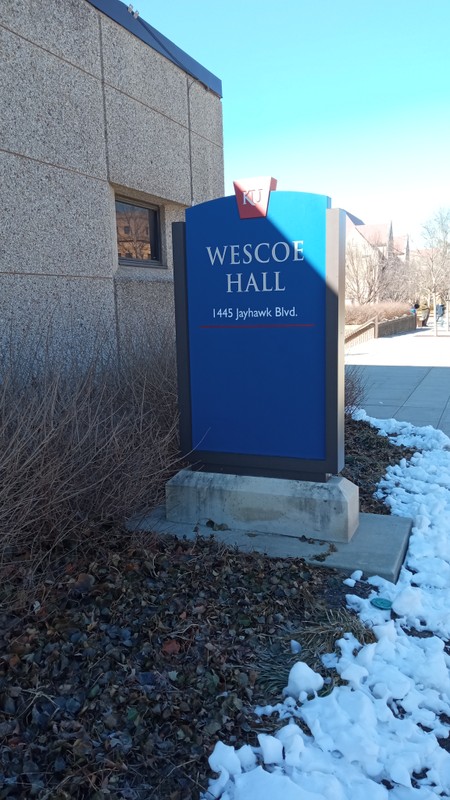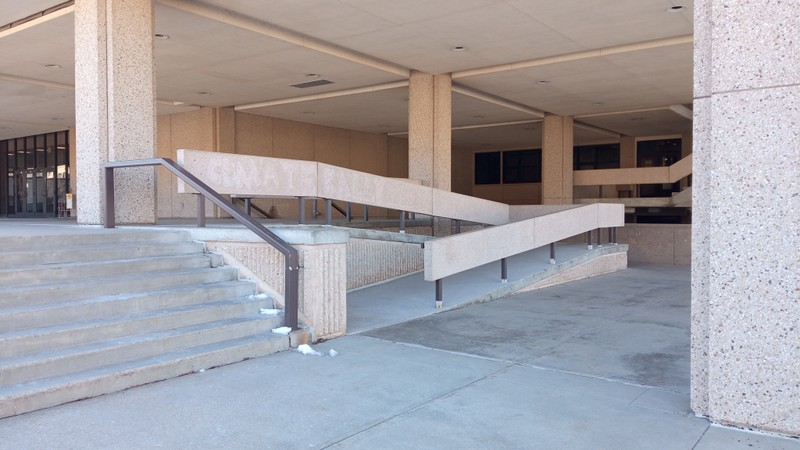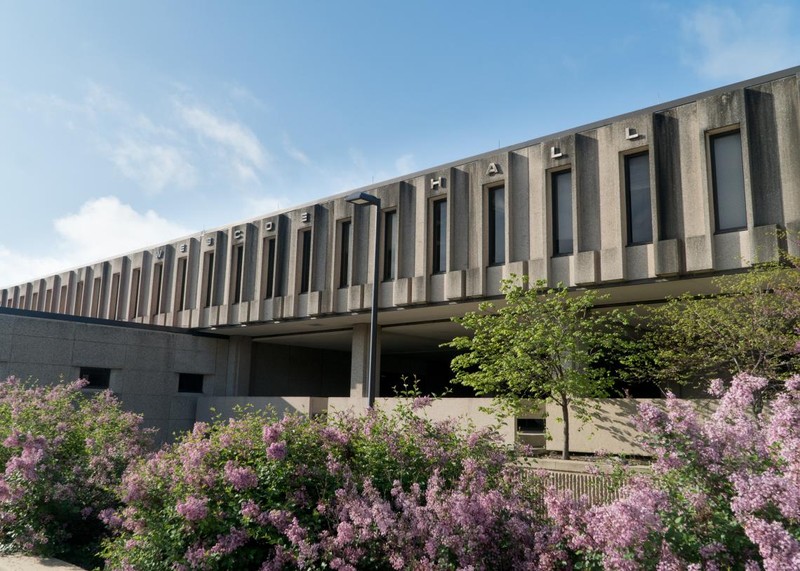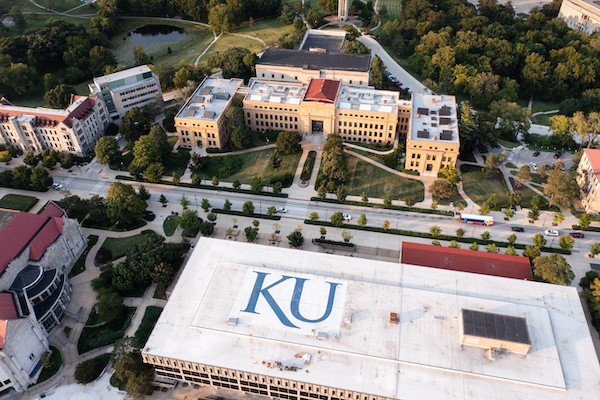Wescoe Hall, University of Kansas
Introduction
Text-to-speech Audio
Dedicated on April 20, 1974, and named in honor of Chancellor W. Clarke Wescoe, who led the University of Kansas from 1960 to 1969, Wescoe Hall is the central hub for the humanities on the KU campus. Originally planned to be a 25-story skyscraper, the modernist concrete structure has inspired many campus legends and remains a center of campus activity. The contrast between the ambitious original plans and the modest four-story building reminds many of the transition seen at many American universities from an education centered on the liberal arts to investment in other fields. The building's location and design have led many to believe it was intended to be a parking garage, while others assume its Cold War-era origins suggest it was intended to double as a bomb shelter. The building replaced the original Haworth Hall and Robinson Gymnasium, which were demolished in 1969.
Images
Sign for Wescoe Hall at the University of Kansas.

The accessible ramp outside of Wescoe Hall, near the “Wescoe Beach” area.

Wescoe Hall, photo taken from Wescoe Beach

Aerial photo of Wescoe Hall

Backstory and Context
Text-to-speech Audio
In 1966, faced with the familiar problem of fitting a growing student body into a limited amount of space, the University of Kansas procured $1.9 million in federal grant money and paired it with $3.9 million in state funding to construct a new building. KU hired Wichita firm Woodman and Van Doren to design a structure which would house the scattered humanities departments. Woodman and Van Doren proposed a grandiose vision for Wescoe hall.
The Wichita firm’s plan was a towering complex 25-stories high with attached five-story wings, all accompanied with a parking garage to fit 150 cars (hence the popular legend that Wescoe is a refurbished parking garage). Woodman and Van Doren’s vision was grand, but the University couldn’t afford the cost. The firm’s design did not attract a bid lower than $7 million, substantially above the $5.8 million KU had allocated towards the project. Facing a looming expiration of federal funds, the University pivoted towards a shrunken down 15-story building.
By December of 1968 KU had lost access to time sensitive federal funds, the only marker of progress being an excavated foundation which students would name “Wescoe Hole.” As the 1969 school year came around, it was clear that more space was necessary, and the University pursued a scaled down construction of Wescoe at all costs. Topeka Architecture firm Horst, Terrill, and Karst were hired and presented the Wescoe of today, a dramatically scaled down four story building which would cost $8 million, a million more than the highest bids for the original 25-story plan. Despite the disappointment and financial pain associated with the Topeka firm’s plan, the University desperately needed space and began construction.
Facing a pressing need for additional funding, the University turned towards its students to help complete Wescoe Hall. On February 18, 1970 the Student Senate approved $7.50 in additional student fees for all those enrolled. Though unpopular by a near 2-1 count of the student body, the fees would raise $1.6 million for the construction of Wescoe Hall. Classes began in Wescoe in April of 1973, prior to its April 20, 1974 dedication, and prior even to the building's total completion.
Perhaps the student body have never quite forgiven the raise in fees, but since its construction Wescoe Hall remains a favorite target of mockery. Despite the many insults hurled at its concrete walls, Wescoe is integral as the home for humanities, and as the advertising board for student life. Wescoe Beach, the ironically named concrete front yard of the hall, is constantly in use during the Fall and Spring semesters. The Beach is a popular spot for tabling, Greek life recruiting, and anyone else looking to accost innocent passerby. Though Wescoe is teased, those whose academic careers push them into its walls earn a deep love for the building, and recognize it as a linchpin for the University of Kansas.
Cite This Entry
Admin, Clio, Humanities Kansas, and Levi Cromwell. "Wescoe Hall, University of Kansas." Clio: Your Guide to History. September 1, 2023. Accessed March 21, 2025. https://theclio.com/entry/164601
Sources
McCool, John H. FROM SKY-SOAR TO EYESORE, KU History. November 20th, 1967. https://kuhistory.ku.edu/articles/sky-soar-eyesore.
https://www.humanitieskansas.org/get-involved/kansas-stories/people/kansas-1972-ramp-it-up
“Wescoe Hall.” KU Directory of Places, https://places.ku.edu/buildings/wescoe-hall
Heacock, Megan. 2010. “The changing face of KU's home-court | News | kansan.com.” The University Daily Kansan, March 12, 2010. https://www.kansan.com/news/the-changing-face-of-kus-home-court/article_44b326d8-96fc-5f02-8374-31f09cdc6869.html.
Photo by Kit Auner.
Photo by Kit Auner.
https://places.ku.edu/buildings/wescoe-hall
https://news.ku.edu/2021/09/22/wescoe-hall-roof-repair-came-free-extra-giant-k-u

